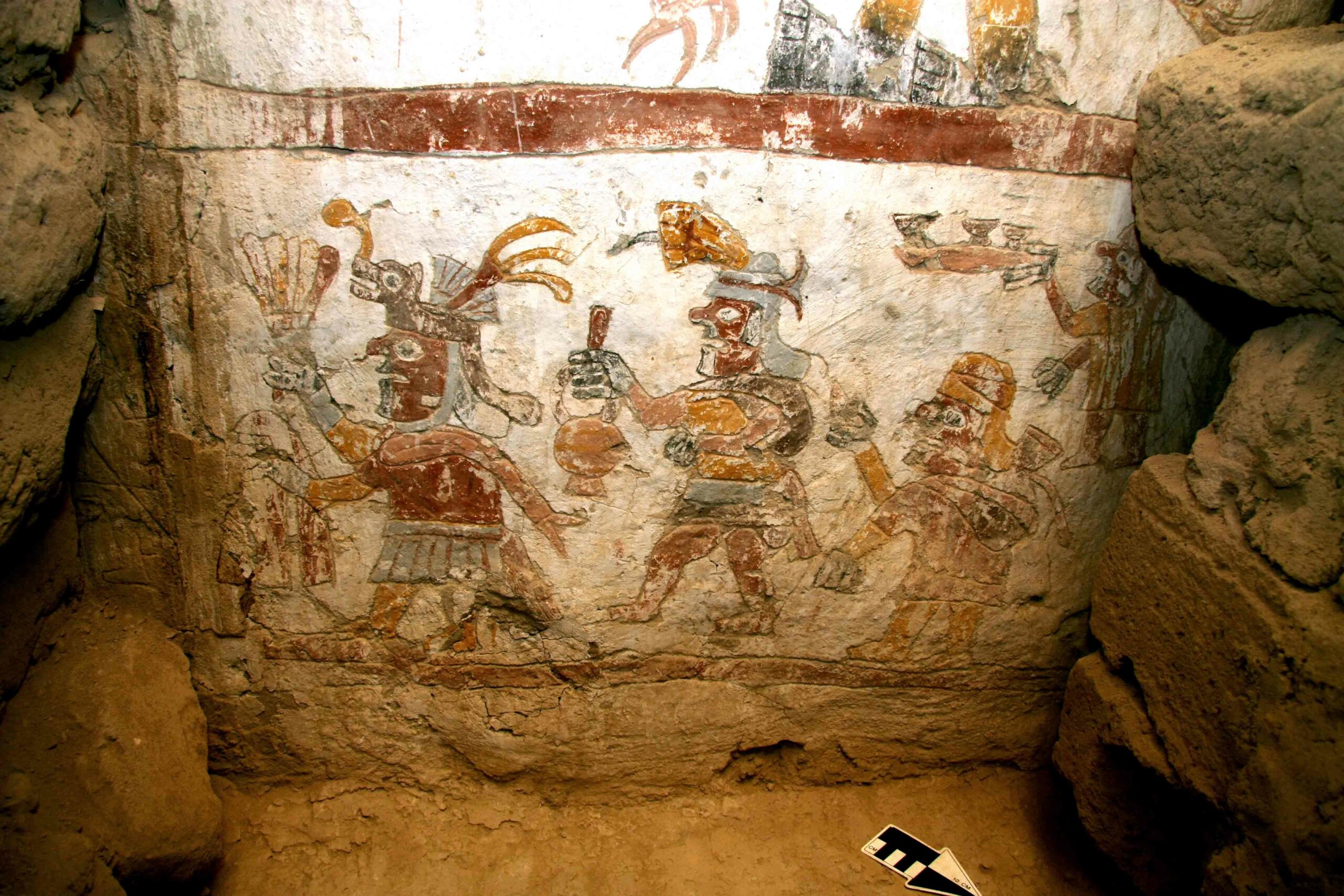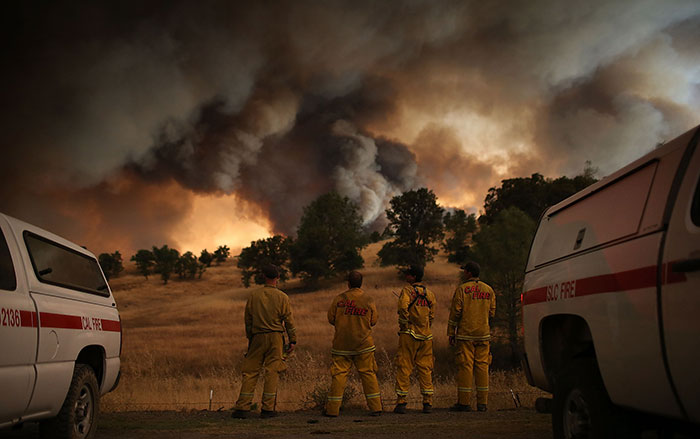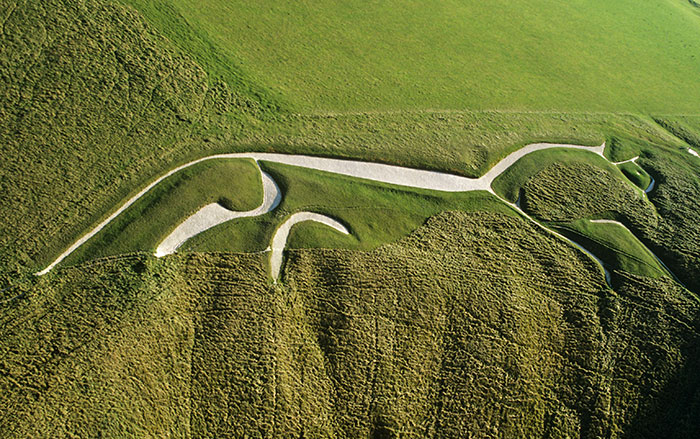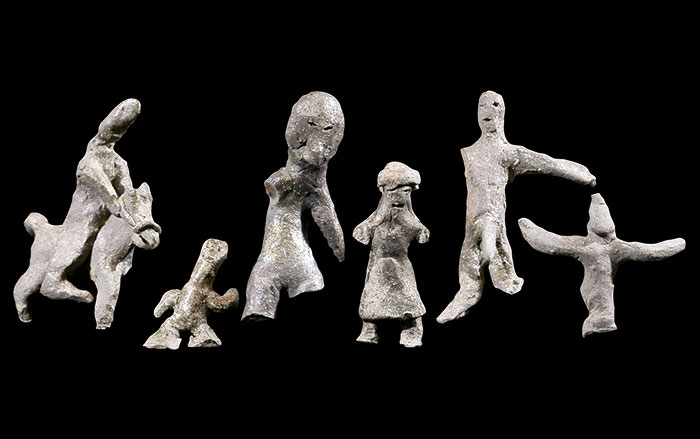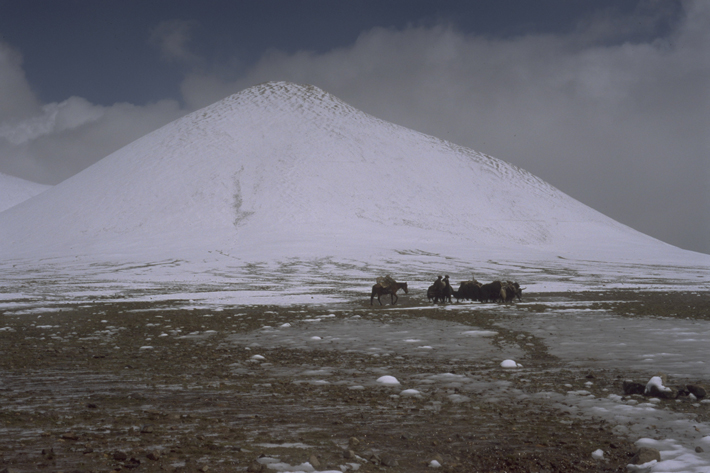
High-altitude landscapes are some of the most inhospitable places on Earth. They are cold, dry, and oxygen-poor. They were the last places humans settled—yet people did it and they survived. But how? For archaeologist Mark Aldenderfer of the University of California, Merced, a fundamental trait of humanity is our ability to adapt, especially to extreme environments. From the Himalayas to the Andes to the Ethiopian Plateau, people have evolved in ways that allow them to live at high altitude. “They’ve all converged on a solution,” he says. “They’ve all found a way to live at high elevation.”
Aldenderfer has assembled a team of experts in disciplines ranging from bioarchaeology to ethnography, paleoclimatology, geochronology, genetics, evolutionary medicine, and even mountaineering to augment archaeological research in order to understand what has clearly come about by way of evolution. He says, “You need the story of the people who lived at that time to tell you how these things actually worked. It’s about the whole process by which people adapt culturally, biologically, and genetically.”
Aldenderfer began his research in the 1970s as a graduate student on the Ethiopian Plateau, one of the highest in the world, where he studied the remains of the Iron Age trading empire of Aksum. Political turmoil cut his research short, and it became impossible to go back. A short while later, he took a research position high in the Peruvian Andes, studying early hunter-gatherers. Aldenderfer realized he had stumbled into a niche of untapped archaeological research on early human adaptation to high-elevation environments.
Working at such heights can be excruciating. A throbbing head, aching lungs, sleeplessness, fatigue, wheezing, coughing, confusion, and rapid pulse are all associated with hypoxia, a condition where tissues can’t get enough oxygen. It occurs when people accustomed to living at lower altitudes climb above 8,000 feet, and it can be dangerous and lead to pulmonary edema, stroke, and even death. Women who aren’t adapted to high elevations can have a much harder time bearing children and risk having low-birth-weight babies. Nevertheless, people have successfully settled at these altitudes for millennia—perhaps 7,000 years or more. The question is, how does such an adaptation come about? Jacqueline Eng, Western Michigan University biological anthropologist and osteology expert on Aldenderfer’s team, explains, “When we’re challenged by the environment, if some individuals have genetic traits that enable them to survive and reproduce more successfully than others who lack that trait, then those with the beneficial traits live and pass those traits along until it becomes more common in populations owing to the advantage it confers.”

It can be observed that, compared with people who live at sea level, Tibetans breathe more frequently and take in more oxygen, and they have expanded blood vessels that enhance the delivery of oxygen throughout the body. Andeans have higher levels of hemoglobin, the protein responsible for transporting oxygen in the bloodstream, so their blood cells carry more oxygen than those of lowlanders. Studies of highland Ethiopians, too, indicate genetic adaptations to low-oxygen environments. Something must confer these adaptations. Eng says there are several telltale alleles found in high-altitude populations where hypoxia is a major challenge. An allele is one of multiple versions of the same gene that determine various physiological traits—blood type in humans, for example, or the distinct color of a rose. Alleles can be thought of as recipes for the same gene—think of the difference between spaghetti with meatballs and spaghetti with ground beef. In evolutionary terms, random mutations create new recipes for alleles that may eventually come to exist throughout a population.
In the case of Himalayans, ancient and modern, two particular alleles have promoted adaptation to high elevation and the avoidance of hypoxia. One of those alleles is known as EGLN1, which, Aldenderfer says, is estimated to have appeared around 8,800 years ago. Another allele, EPAS1, has a fascinating origin story. It dates back to the Denisovans, an extinct hominin species that lived in the Altai Mountains of Siberia some 45,000 to 50,000 years ago. Scientists do not yet understand where or how, but it seems that, at some point, the Denisovans encountered early modern humans and, somewhere along the way, their EPAS1 gene ended up on the Tibetan Plateau.
Recovering the ancient DNA that allows for these conclusions is meticulous work, and is hampered by the fact that many of the world’s highland environments, such as those in Ethiopia and Tibet, are politically unstable or otherwise off-limits. Nevertheless, Aldenderfer’s team has been able to conduct what appears to be the first investigation of the ancient DNA of the people of the Himalayan arc. They have sequenced the genomes of eight individuals who lived during three distinct cultural periods between 1,250 and 3,150 years ago, in what is now Upper Mustang, Nepal, at altitudes between about 9,000 and 14,000 feet. The team’s primary questions are: Where did these people come from? Did they have the adaptive alleles for high altitude? If so, which ones? And how do the genetic findings relate to any artifacts found nearby?
There have been many hypotheses about the identities and origins of early people living in these high valleys, with some researchers suspecting that they came from elsewhere in Asia. But according to Christina Warinner of the Max Planck Institute for the Science of Human History in Jena, Germany, who is responsible for DNA extraction from the human remains from Upper Mustang, the genome sequencing has revealed that “genetically, these people are almost certainly coming from the Tibetan Plateau—they look very similar to present-day Tibetan populations.”
Warinner works with Anna Di Rienzo of the University of Chicago’s Department of Human Genetics, who directs the team’s genomics research. By identifying the alleles that promote adaptation to high elevation and then comparing those of the closest modern population to those in the ancient samples, the team has found that while cultures, religions, and behaviors shifted dramatically through the centuries, their genetics did not. “Genetically they were very, very stable,” says Warinner, “and that’s uncommon.” The researchers also found strong evidence that one of the adaptive alleles, EGLN1, is present throughout all time periods studied. The other—EPAS1, the gene that originated with Denisovans—appears only in the most recent period studied. Warinner is not yet certain why this is the case.
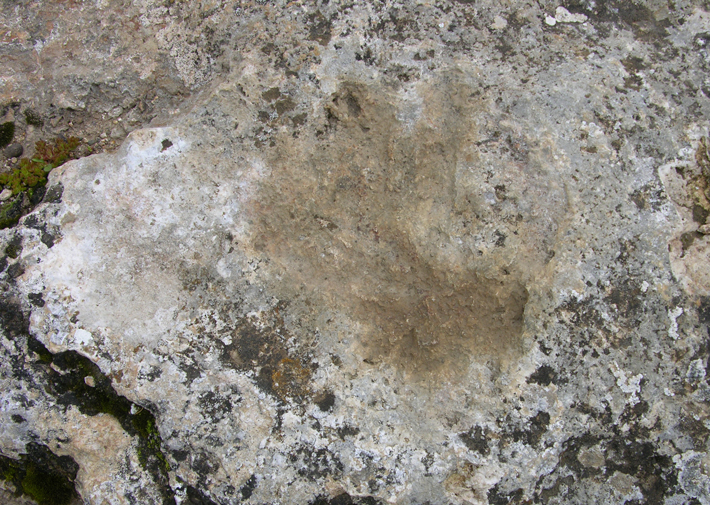
Aldenderfer and several of his colleagues created a stir in early 2017 when they announced that they had evidence of preagricultural hunter-gatherers living in a permanent settlement system on the central Tibetan Plateau at least 7,400 years ago—thousands of years earlier than researchers had previously thought. That research centers on a site called Chusang, about 215 miles from Lhasa, at an elevation of 14,000 feet. There, 19 human hand- and footprints are embedded in a unique formation of travertine limestone created in the remains of ancient hot springs. No artifacts were found nearby, just the markings of up to six individuals who were at that site millennia ago.
Without artifacts, the researchers had to rely on research methods such as geochronology and a variety of other dating techniques. Aldenderfer’s team hypothesizes that Chusang was one stop in a permanent preagricultural occupation, and that the prints were made by early hunter-gatherers who settled on the plateau year-round. The finding is pivotal for several reasons. First, it clarifies Chusang’s age, which had long been debated. Some previous research had pinned the site at 20,000 years old or more, which perplexed many researchers, as that would have meant humans were present there during the height of the Last Glacial Maximum. The new dates—7,400 to 13,000 years ago—“are more consistent with what we know about the broader region,” says the University of Pittsburgh’s Loukas Barton.
But Barton finds the team’s interpretation of the new dates problematic because of the preagricultural part of the argument. Barton, like several others, hypothesizes that it was the introduction of agriculture to high-elevation regions that enabled early Tibetans to survive at such heights. Agriculture was established in this region roughly 3,600 years ago, and Barton’s hypothesis for full-time occupation rests on the existence of agriculture on the plateau. His theory is that population growth and resource scarcity pushed early farmers higher up the mountains. They had sheep, barley, and wheat, which offered a food supply that could be stored year-round. And while they were up there, natural selection took hold, fostering the spread of the alleles that prevent hypoxia. He says this is an example of “gene/culture coevolution.” He says it shows “how culture broadly drove the biological evolution of the human capacity for low-oxygen environments. It means that these biological capacities evolved in a relatively short period of time, maybe 1,000 to 1,500 years.” That’s fast for human evolution—and he wonders what it could mean for the future, because, as he notes, humans are still evolving.
“Chusang could easily have been a seasonal encampment of some sort,” says Dave E. Rhode, research professor in archaeology at the Desert Research Institute, who has a decade of experience working on a different part of the Tibetan Plateau. He also disagrees with the preagricultural interpretation. “I have a very hard time seeing how it could be a permanent year-round camp [without agriculture].” The resources up there are so sparse, he thinks staying put would quickly exhaust the food supply. “Unless Chusang was some remarkably salubrious, sweet-spot Shangri-La, people would not have wanted to stay there permanently.”
Aldenderfer’s team, however, believes it would have taken too much time—28 to 70 days round-trip, depending on the route—for hunter-gatherers to travel between Chusang and a lower-level base camp. Plus, heavy snowfall would have made one possible route impassable much of the year. Michael Meyer, a geochronologist at the University of Innsbruck and a member of Aldenderfer’s team, says the data suggest the Chusang hot springs were most active and travertine formation was at its height during an age of peak monsoons, with flora and fauna flourishing across the plateau. The researchers think these wetter, more prolific conditions were a “pull” for people to move higher into the mountains. Even today, he says, remote stretches of the Tibetan Plateau are flush with antelope, wild yaks, and bears. Hunting is a profitable—albeit illegal—business. “So for me,” Meyer says, “it is very easy to imagine that a slightly wetter climate would make a big difference in terms of food availability for ancient tribes and societies, facilitating human migration during much earlier times.”
Aldenderfer and his team don’t think Chusang was a permanent occupation in and of itself. Instead, the researchers believe that the site would have been one of many stops on a seasonal occupation of the higher elevation of the plateau. People moved around the plateau, but there was no seasonal migration to lower sites. Furthermore, Aldenderfer says, both adaptive alleles found in modern-day Tibetans— EGLN1 and EPAS1—have been dated to ages that coincide with or precede the time when a few folks left their imprints in the Chusang mud. Genetically, they would have been preadapted to the altitude.
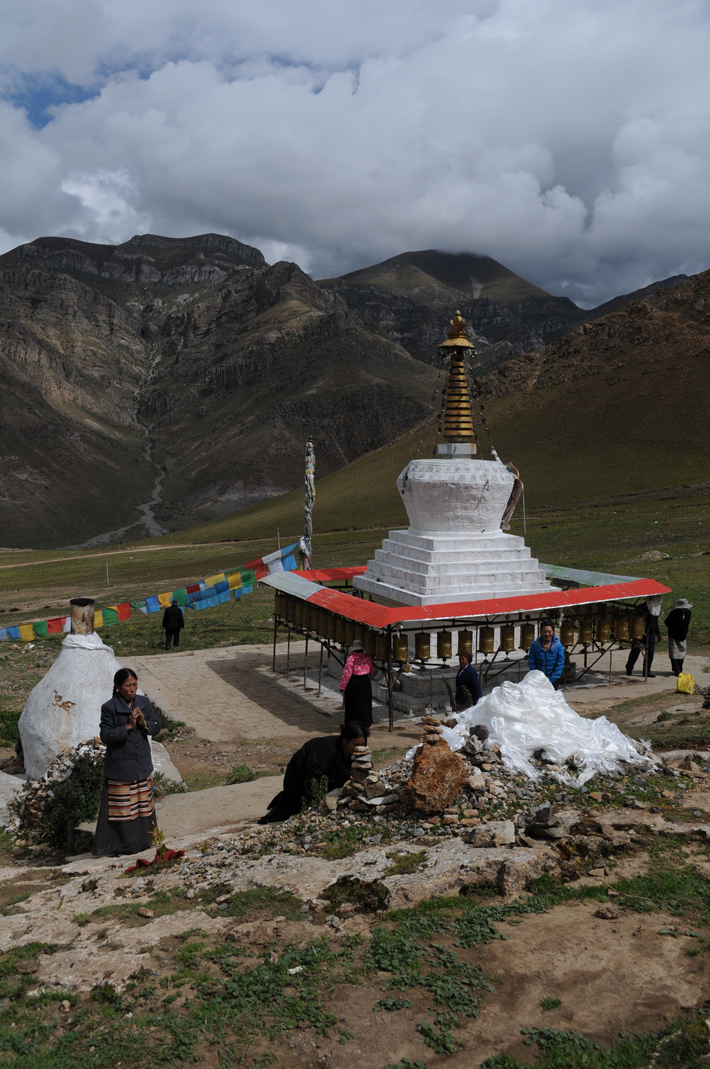
One might ask why the whole debate is so critical. It is primarily because it touches on the broader question of adaptability. Looking at the time when humans first appeared on the plateau and how they managed to survive offers “a measure of the limits of human possibility,” says Jeff Brantingham of the University of California, Los Angeles. Earth is full of extreme environments where people today face dire choices about survival, he says. “Learning something about how such inhospitability was successfully conquered in the past tells us something about what happens on the edge today.”
Aldenderfer plans to expand his project across the Himalayan arc. He is also working with his colleagues and former students on genetic and isotope studies of early Andean hunter-gatherers to compare with the results from the Himalayas. In the Andes, research shows that people lived year-round at elevations exceeding 8,000 feet at least 7,000 years ago. “These early hunter-gatherers intensively processed tubers—a behavior that may have led to the domestication of the potato,” says archaeologist Randy Haas of the University of California, Davis, who worked with Aldenderfer. Aldenderfer believes that archaeology, in concert with other disciplines, is providing opportunities to look at differences and similarities across evolutionary time. “We’re exploring our common humanity here,” Aldenderfer says. “I think that’s something that we don’t do enough of—it’s important because it tells us something about us.”
High Altitude Genetics
Photojournalist Jerry Redfern traveled to Merced, California, to speak with archaeologist Mark Aldendefer about his work on the genetics of high altitude adaptation. Aldenderfer has conducted his research on the world’s high plateaus, in Nepal, Tibet, Ethiopia, and South America.






